Luận án Utilization of banana stems for local pigs (kandol) in mountainous Ratanakiri province of Cambodia
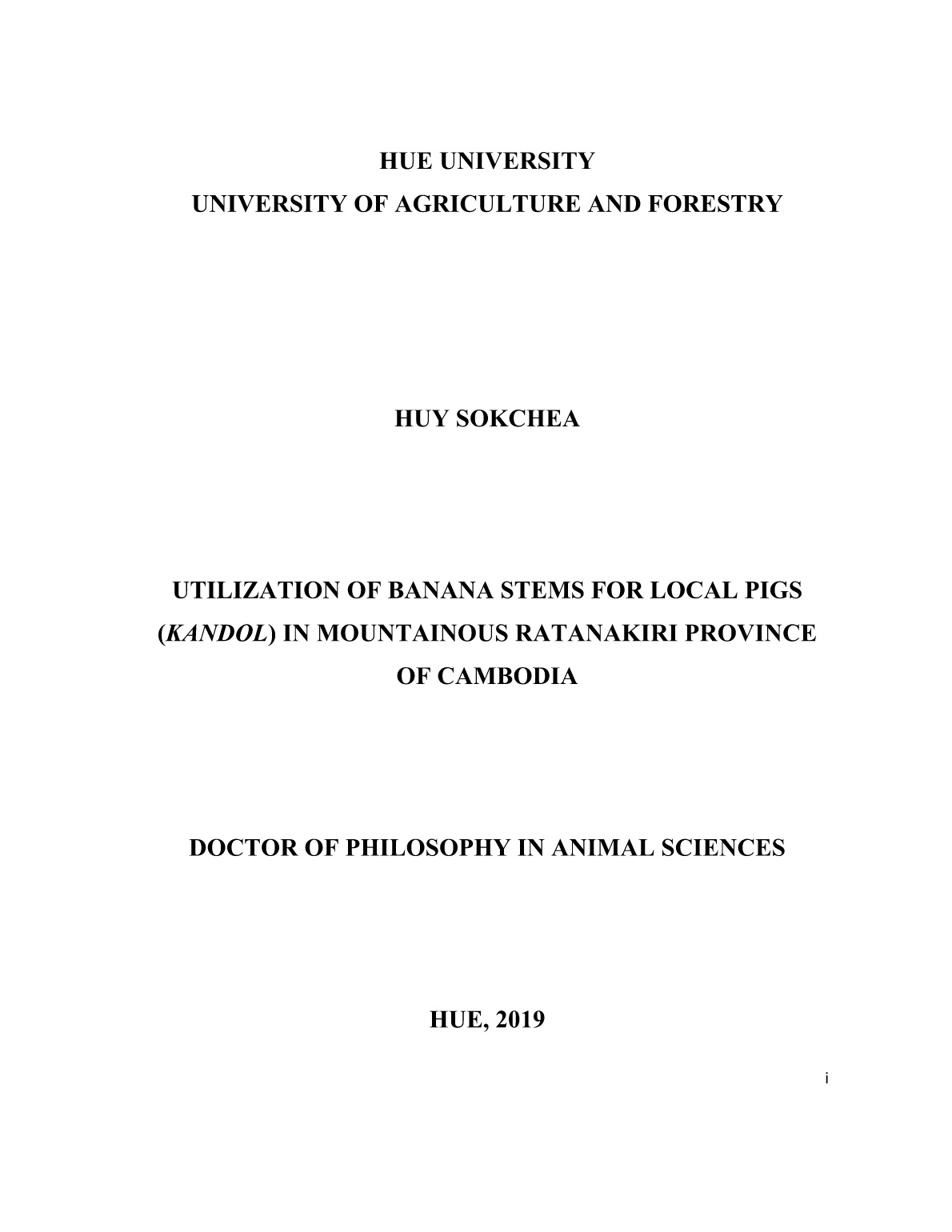
Trang 1
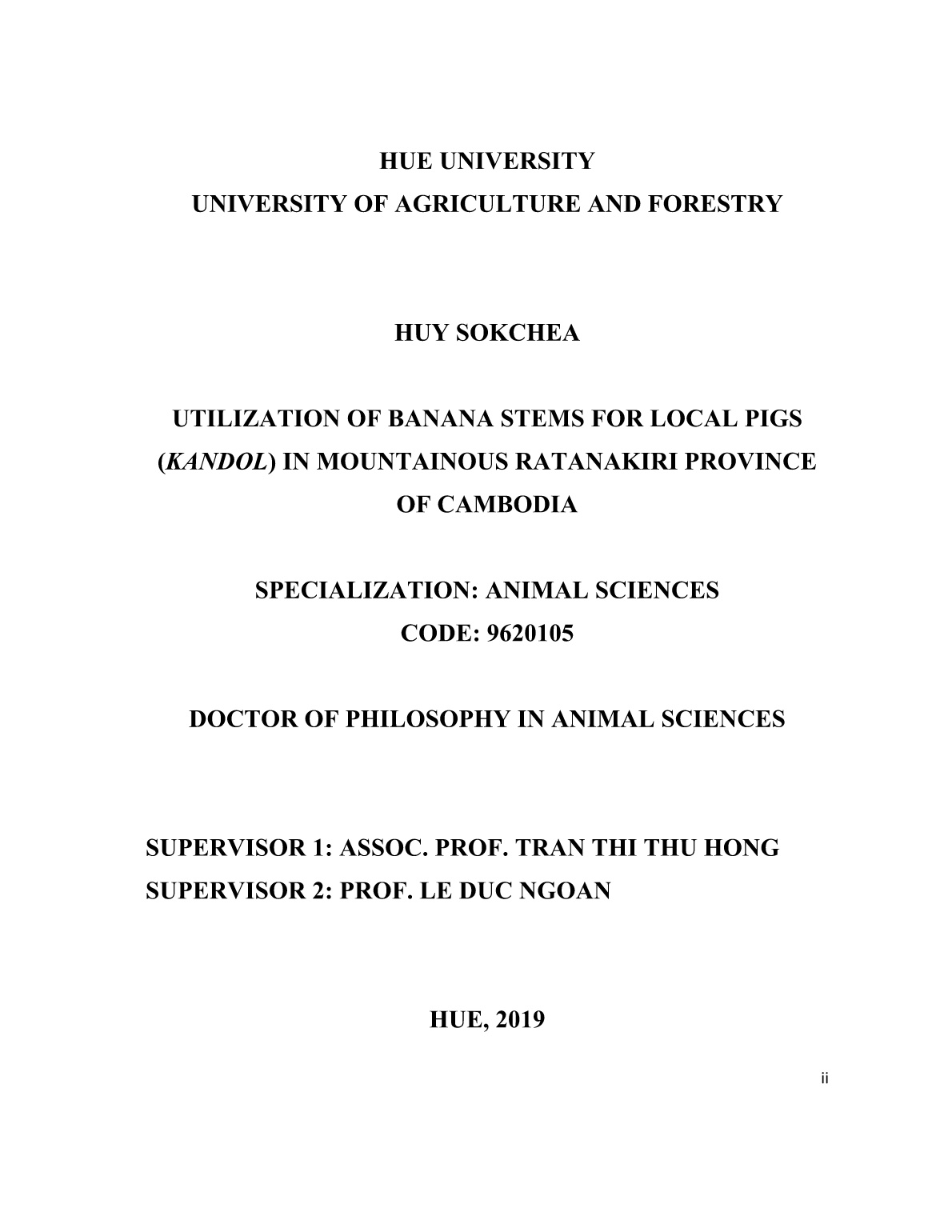
Trang 2
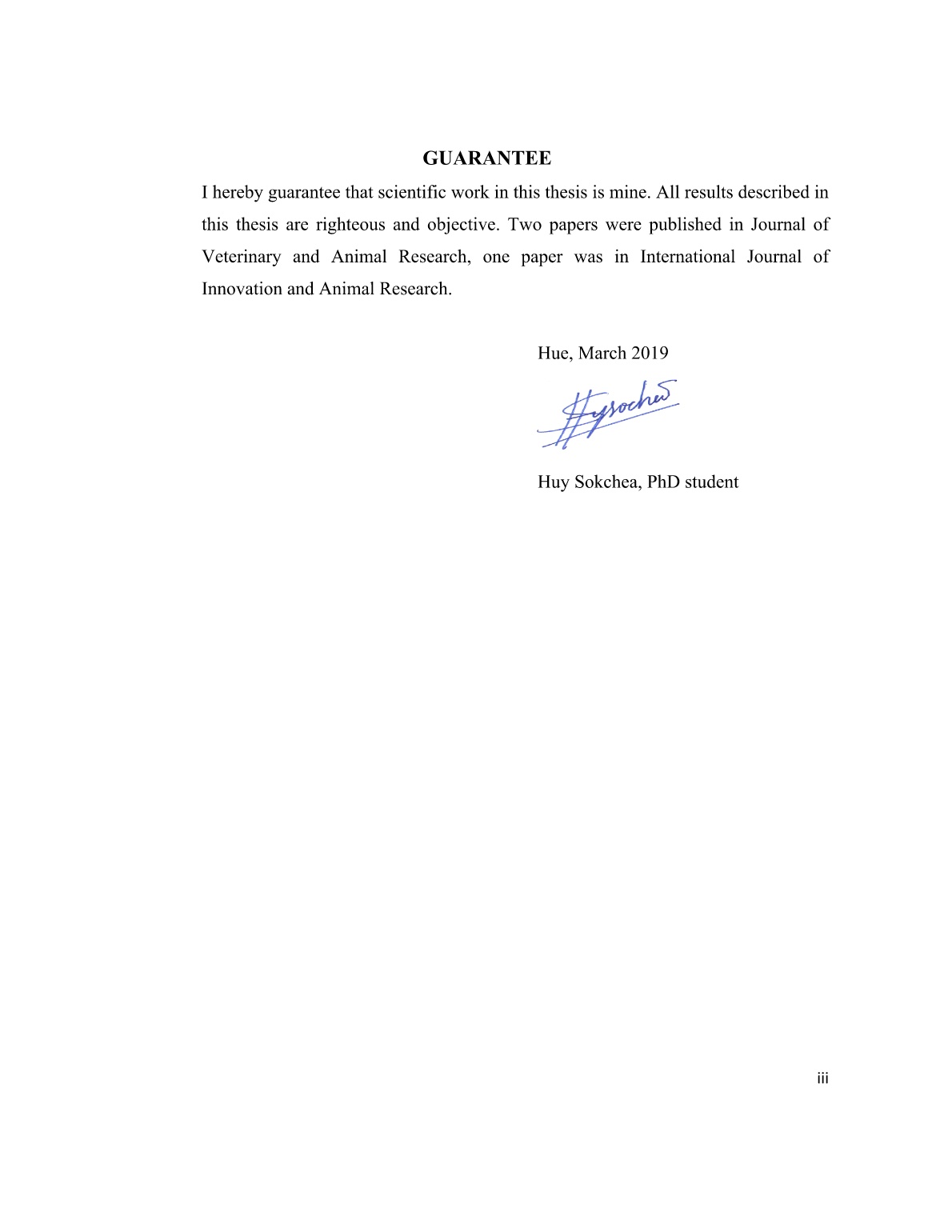
Trang 3
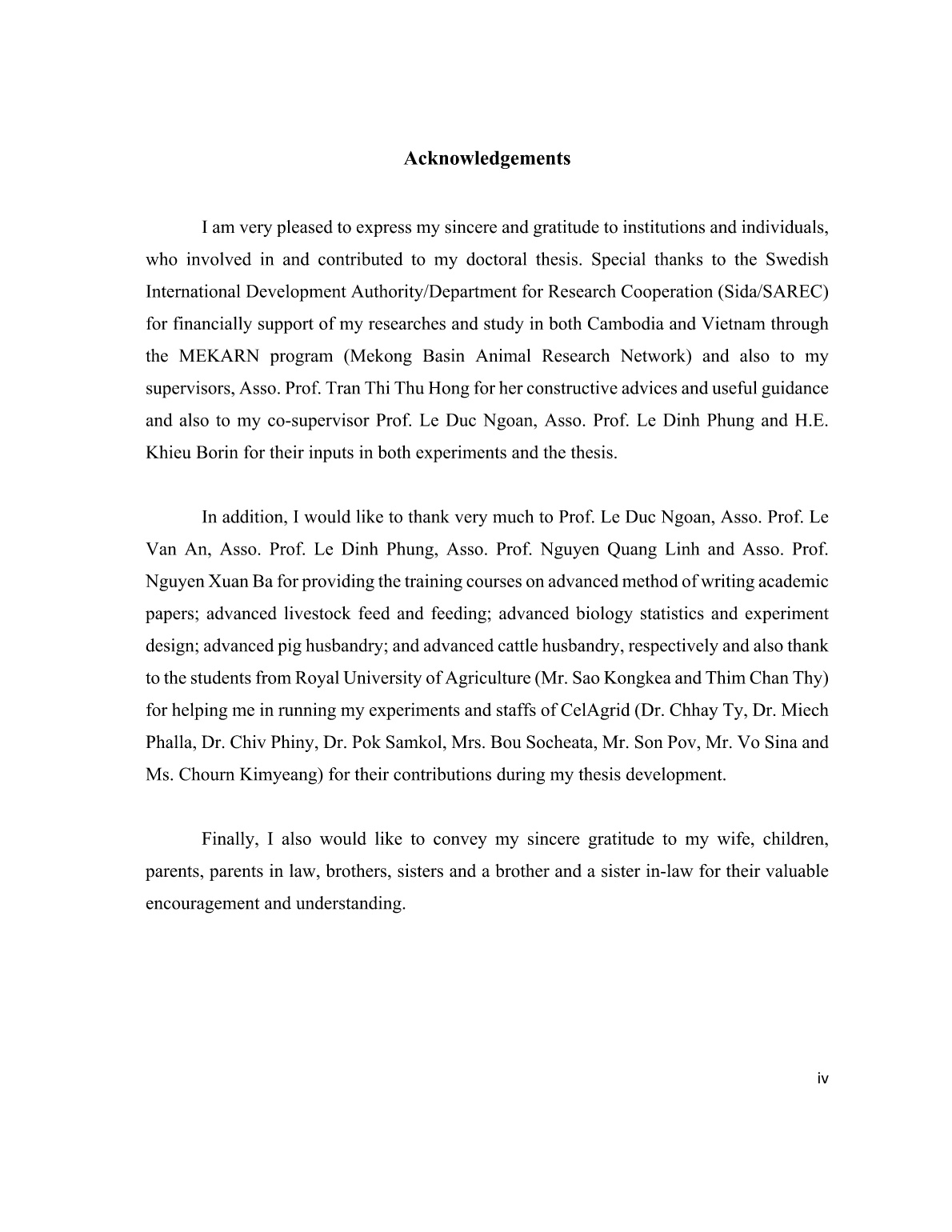
Trang 4
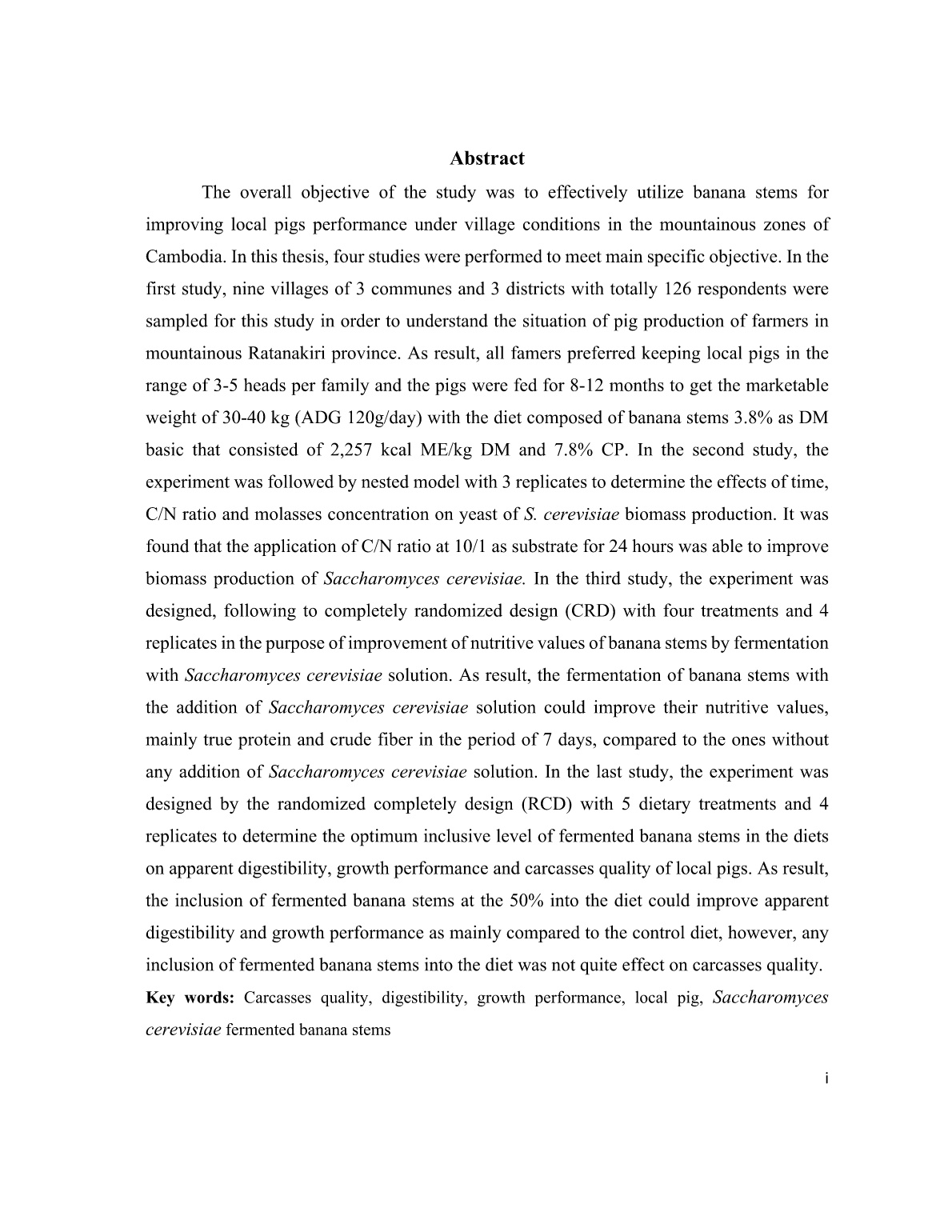
Trang 5
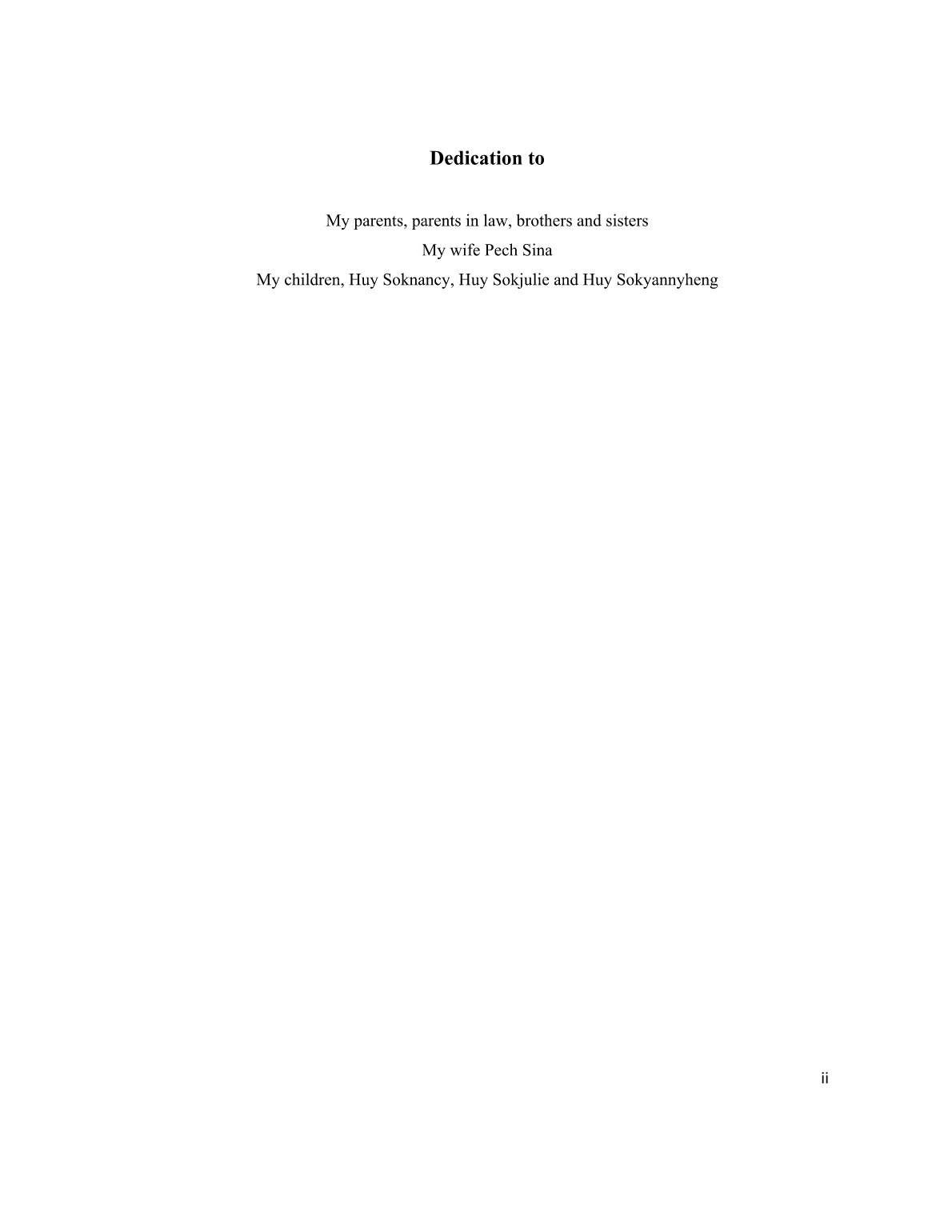
Trang 6
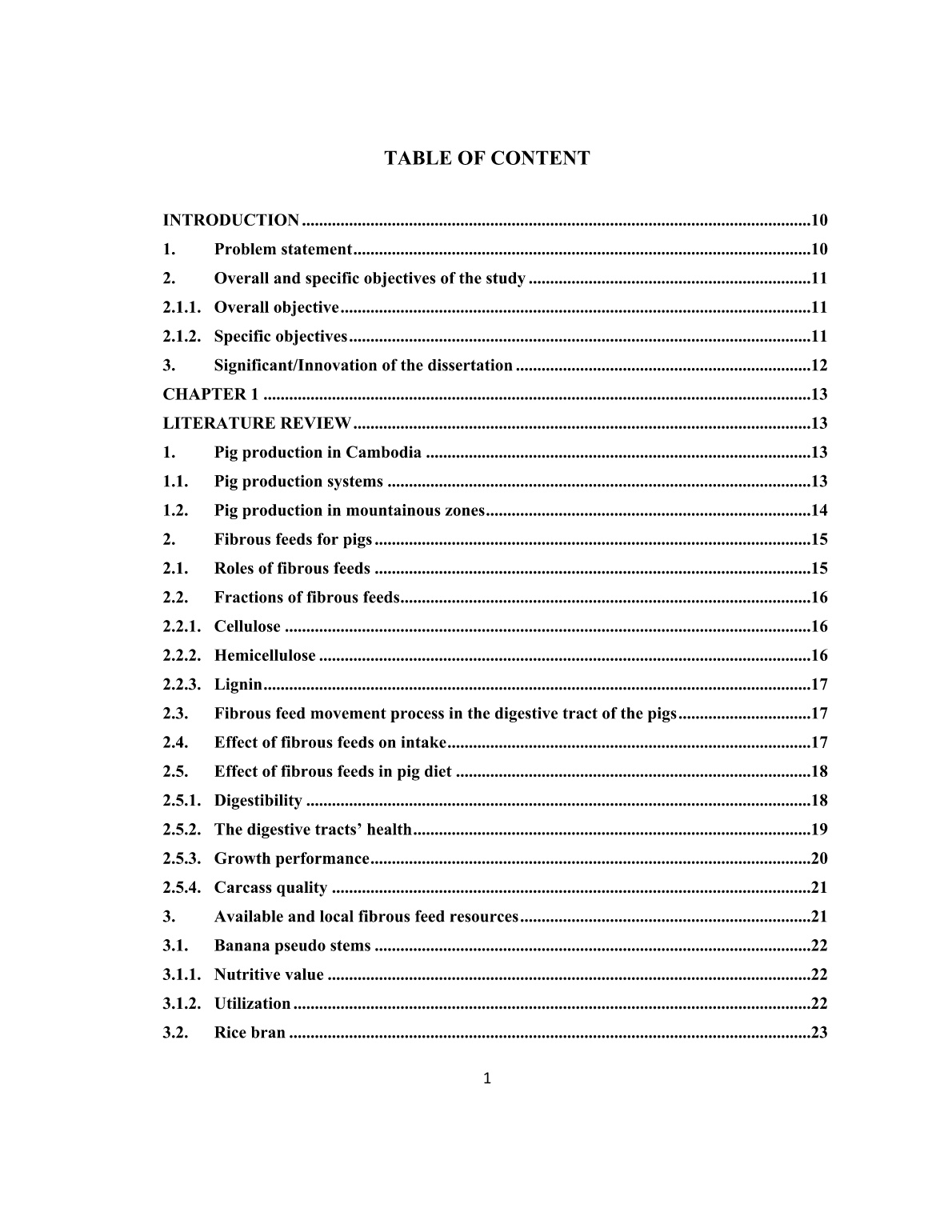
Trang 7
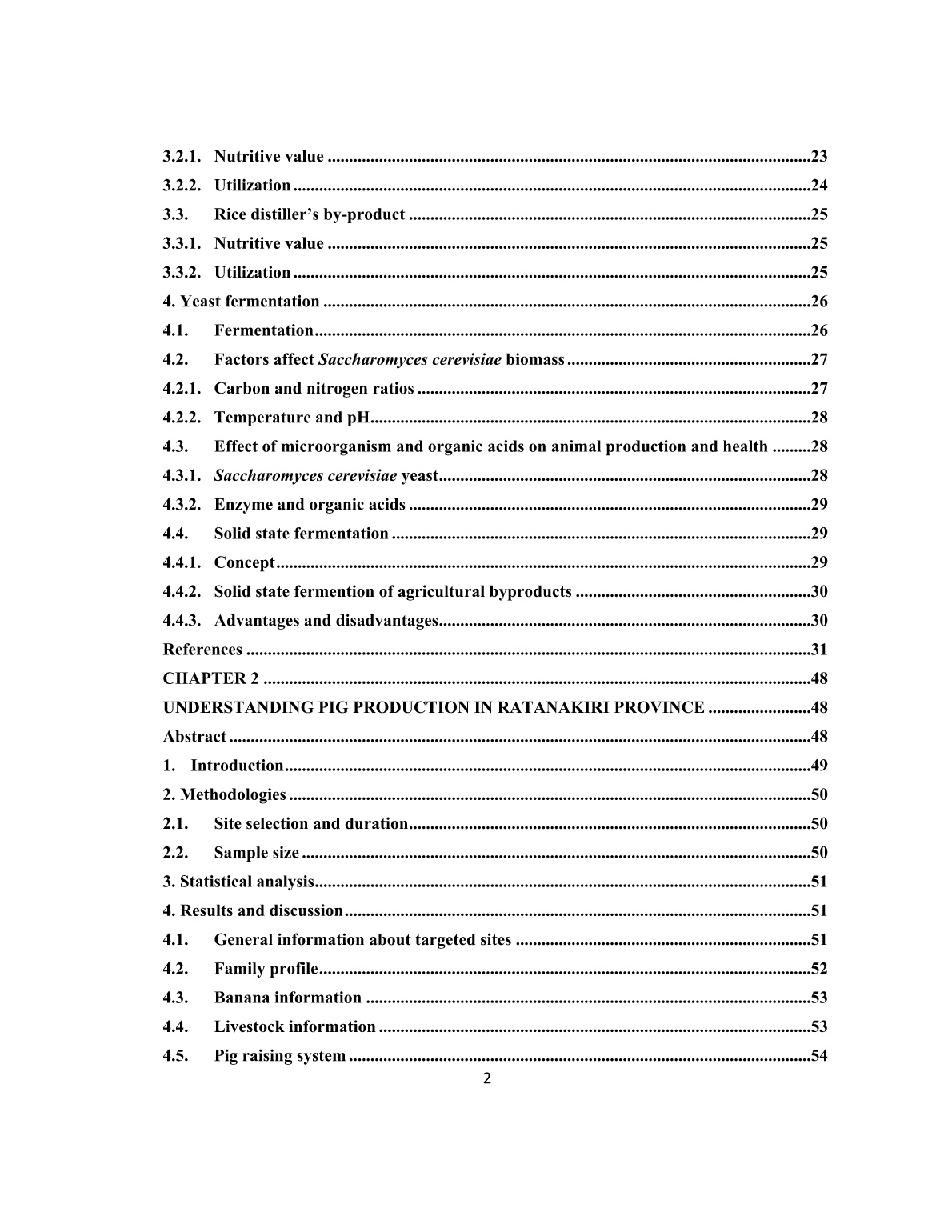
Trang 8
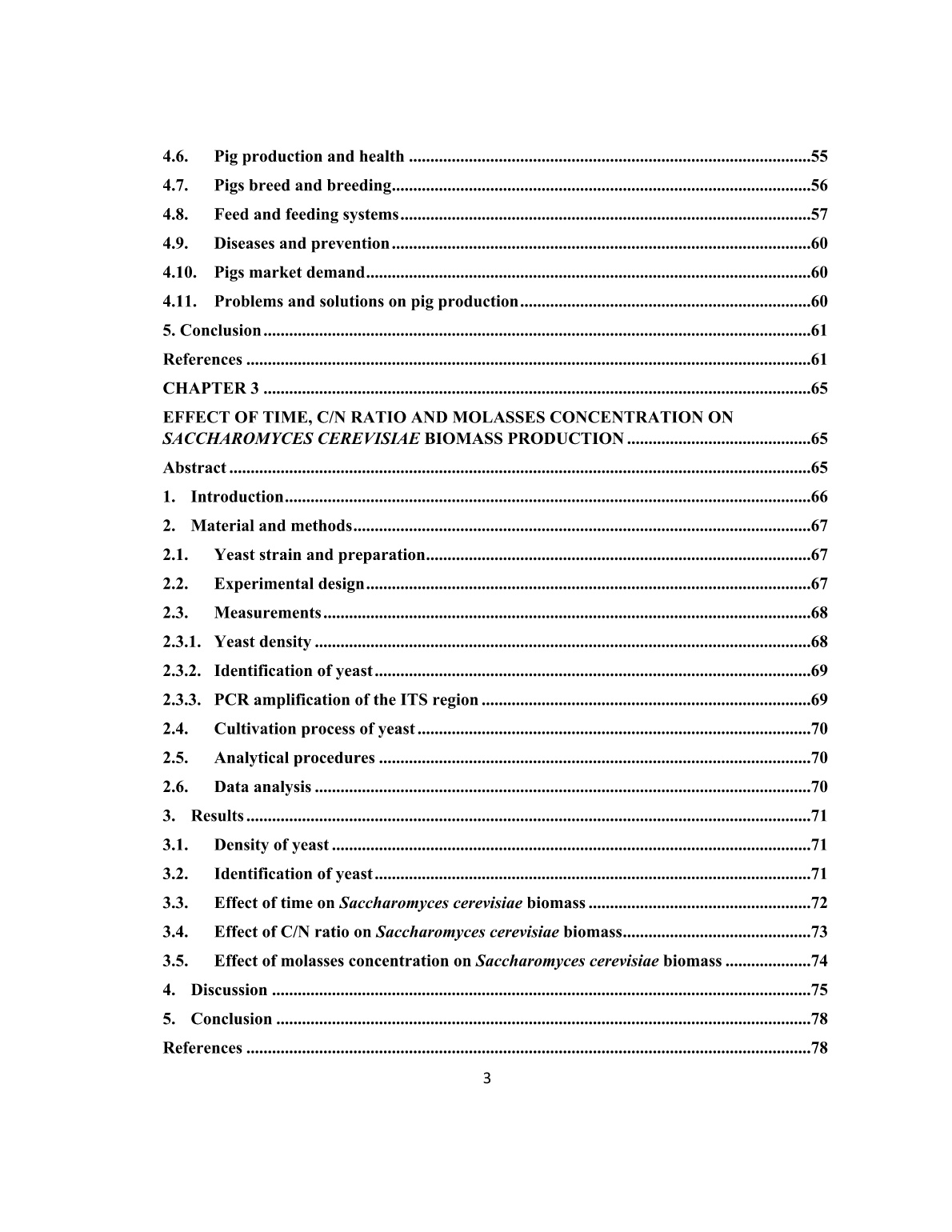
Trang 9
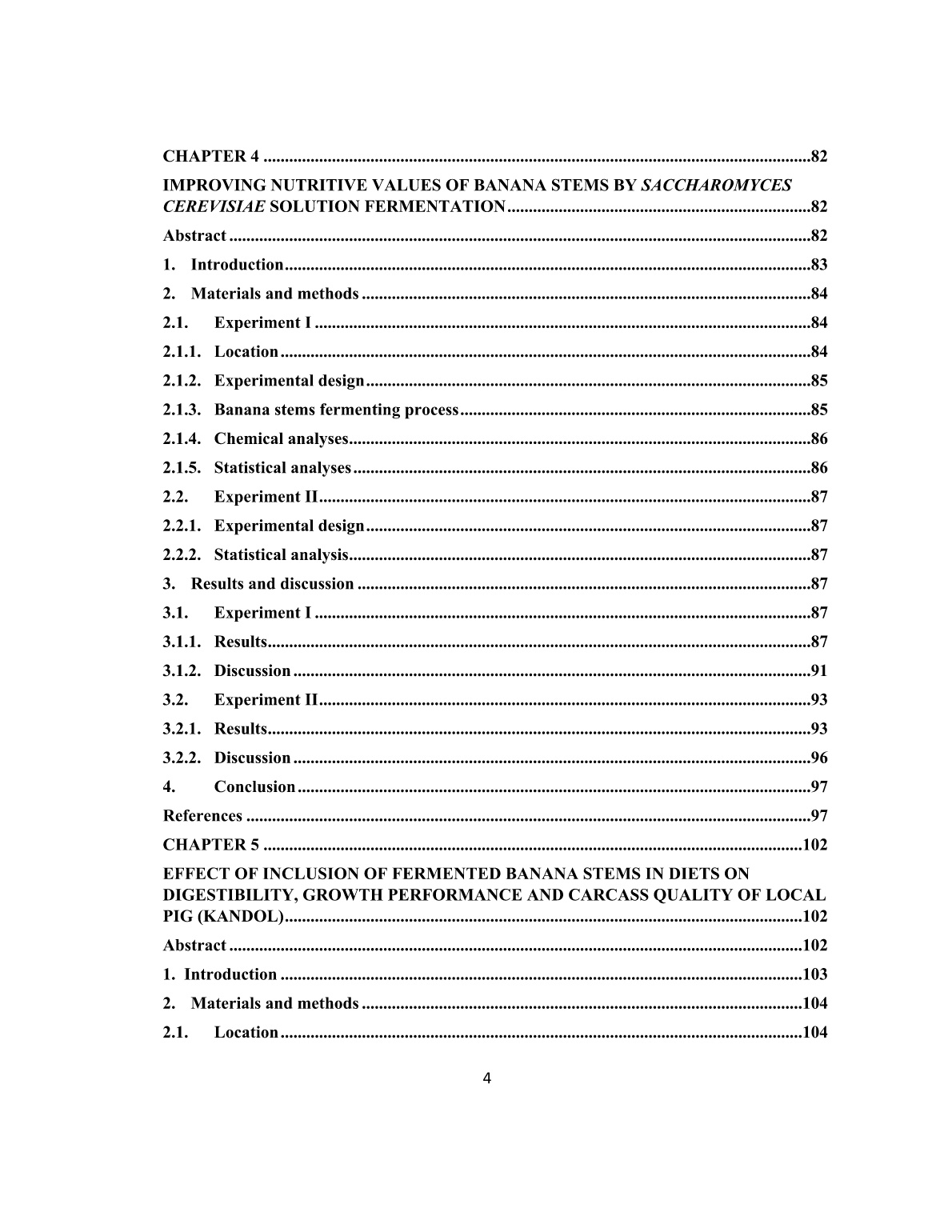
Trang 10
Tải về để xem bản đầy đủ
Bạn đang xem 10 trang mẫu của tài liệu "Luận án Utilization of banana stems for local pigs (kandol) in mountainous Ratanakiri province of Cambodia", để tải tài liệu gốc về máy hãy click vào nút Download ở trên.
Tóm tắt nội dung tài liệu: Luận án Utilization of banana stems for local pigs (kandol) in mountainous Ratanakiri province of Cambodia
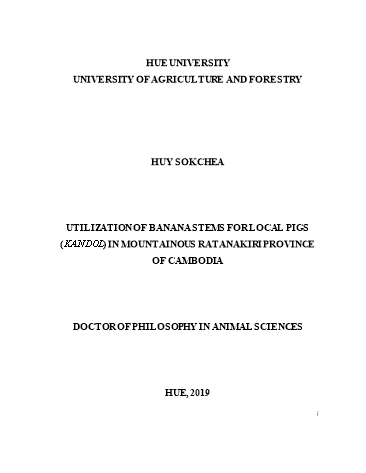
or biosecurity in the pig sector, issues and options in developing and transition countries. FAO Animal Production and Health Paper No. 169. Rome. Fox, J., Vogler, J.B. and Poffenberger, M., 2009. Understanding Changes in Land and Forest Resource Management Systems: Ratanakiri, Cambodia. Southeast Asian Studies, 47(3), 309-329. Hay, S., Chham, I. and Por Sy, K., 2014. Ratanakiri Province, Municipality and Province, Investment Information. uploads/2014/03/Ratanakiri-Province_eng.pdf. Huynh, T.T.T., Aarnink, A.J.A., Drucker, A. and Verstegen, M.W.A., 2006. Pig Production in Cambodia, Laos, Philippines, and Vietnam: A review http:// ageconsearch.umn. edu/record/165789/files/AJAD_2006_3_1_2_5Hyunh.pdf. IFAD, 2013. Rural Livelihoods Improvement Project (RULIP) in Kratie, Preah Vihear and Ratanakiri (DSF-8005-KH) https://operations.ifad.org/documents/654016/fb 15ce 31-76ba-4843-87f3-ea3f27833790. Law on Animal Heath and Production Sector (LAHPS), 2016. law-on-animal-heath-and-production-sector/ Menghak, P., Sokha, T., Kouch, T. and Mom, S., 2014. Working with Ethnic Group: A Case Study of Introducing Pig Fattening to Garay Ethnicity in Ouyadav District, Ratanakiri province, Ministry of Agriculture Forestry and Fishery (MAFF) 2018. Annual Report (2017-2018) and Direction 2018-2019, Phnom Penh, Cambodia. Ministry of Agriculture Forestry and Fishery (MAFF) 2014. Agricultural statistic, Ministry of Agriculture, Forestry and Fishery. National Institute of Statistics (NIS), Ministry of planning, in cooperation with Ministry of Agriculture, Forestry and Fishery, 2015. Census of Agriculture of the Kingdom of Cambodia, pp. 33-34, 49 and 54. Naven, H., Phirom, P., Pheak, H., Sopha, P. and Monyada, S., 2010. Understanding Communication with Indigenous People in Ratanakiri Province, Cambodia Phengvilaysouk, A., Jansson, A., Phengsavanh, P., Tiemann, T., Phengvichith, V. and Lindberg, J.E., 2017, Sow and piglet management in small-holder and larger-scale pig farms in Northern part of Laos. Livestock Research for Rural Development, 29(201), Provincial Department of Agriculture of Ratanakiri (PDAR), 2010. Report of agro-ecosystems analysis of Ratanakiri Province. RUA Team, 2014. Cattle and Pig Market Chain in Rattanakiri Province, Cambodia https://asia.ifad.org/web/1308-ciat/resources/-/resource_library/9426/work-tools Samkol, P., Borin, K. and Sovann, S., 2006. Pig System in South East Asia – The Case of Cambodia. https://www.researchgate.net/publication/262840137_Pig_systems_in_ Southeast_Asia-The_case_of_Cambodia San, S., 2011. Cambodia swine industry profile. National veterinary research institute (NaVRI), Department of animal health and production, Phnom Penh, Cambodia. Saroeun, K., Sokerya, S., Samkol, P., Ty, C., Theara, S., Sunnara, S., Sokchea, H., Soveasna, M. and Borin, K., 2007. Assessment of pig production, feed and feeding practices in three main agro-ecological zones of Cambodia. Center for livestock and Agriculture Development, MEKARN Regional Conference 2007: Matching Livestock Systems with Available Resources. Sovann, S. and San, S., 2002. Pig Production in Cambodia. In Priorities for Pig Research in South East Asia and the Pacific. pp. 22-28, Canberra: Australian Centre for International Agricultural Research. Strửm, G., Djurfeldt, A.A., Boqvist, S., Albihn, A., Sokerya, S. and San, S., 2017. Urban and peri-urban family-based pig-keeping in Cambodia. Characteristic, management and perceived benefit and constraint, 12(8). https://doi.org/10.1371/ journal. Tanachot, P., Chaiyapoom, B., Choawit, R. and Theerawit, P., 2018. Dried Banana (Musaparadisiaca.) For Feeding Pigs: Nutrient Compositions, Growth Performance and Small Intestinal Morphology. Journal of Applied Sciences, 18: 1-8. https://scialert.net/abstract/?doi=jas.2018.1.8 WFP, 2010. Cambodia Food Market Analysis and Survey Report, Cambodia Country Office VAM Unit. ena/wfp244779.pdf. CHAPTER 3 EFFECT OF TIME, C/N RATIO AND MOLASSES CONCENTRATION ON SACCHAROMYCES CEREVISIAE BIOMASS PRODUCTION Abstract The experiment was to promote the Saccharomyces cerevisiae as growth promotor in the improvement of feed nutrition. The experiment was followed by nested model with 3 replicates to determine the effects of time, C/N ratio and molasses concentration on biomass production of Saccharomyces cerevisiae. The molasses concentrations were used from the lowest to the highest, while different levels of urea of 0.5, 1.0, 1.5 and 2.0% were used to calibrate the ratio of C/N in the medium for the grow of yeast and the fermentation time ranged from 0, 4, 8, 12, 24 and 48 h. As the result, the best fermentation time for biomass production of Saccharomyces cerevisiae was at 24h. Saccharomyces cerevisiae biomass was highest at C/N ratio of 10/1 reached 6.68 g L-1. For the molasses concentration of 35.00 g gave the highest biomass of concentration of 7.57 g L-1. Further study on nutritive values improvement of banana stems by S. cerevisiae fermentation would necessarily be more investigated. Keywords: Biomass, C/N, molasses concentration and Saccharomyces cerevisiae. Introduction Saccharomyces cerevisiae has been used to produce foods such as bread, wine, sake and beer. Recently, Saccharomyces cerevisiae was used to produce single cell protein as an animal feed supplement (Nasseri et al., 2011). In monogastric animals, the use of live yeast to improve feed nutrition has become more popular when the Europe ban using antibiotics as an antibiotic growth promoter in animal production since 2006. Any application of antibiotic in the animals feed would improve the resistance of pathogenic bacteria to antibiotics that may be used in clinical or veterinary practice (Hughes, 2004). In addition, Maron et al. (2013) also indicated that U.S restricted any antimicrobial use, following to scientific evidences to preserve the efficacy of antimicrobial drugs for treatment of infections in humans and animals. The use of Saccharomyces cerevisiae in the pigs’ diet could improve growth rate and digestibility, prevented colonization of pathogenic bacteria in small intestine, and increased systemic immune functions (Price et al., 2010; Schen et al., 2017; Jiang et al., 2015). There were several studies on the use of Saccharomyces cerevisiae to ferment cassava pulp and cassava root for animal feed (Boonnop et al., 2009; Oboh and Kindahunsi, 2005; Thongkratok et al., 2010). The results of these studies suggested that cassava root and cassava by-product can be nutritionally improved by Saccharomyces cerevisiae for animal feeding. Tefera et al. (2014) also reported that fermentation of the cassava root meal with starter cultures of Saccharomyces cerevisiae resulted in elevation of crude protein (CP) and decreased pH, free cyanide (FC) and moisture contents. However, to increase biomass of Saccharomyces cerevisiae, the substrate must have enough soluble carbohydrate and nitrogen for the growth of yeast cells. Danesi et al. (2006) reported that the type and concentration of carbon and nitrogen sources, as well as the C and N ratio of the medium for Saccharomyces cerevisiae cultivation influence cellular growth. The use of sugarcane blackstrap molasses and yeast extract at a C and N ratio of 10 gave the highest biomass of yeast. Saccharomyces cerevisiae was able to use some of the nitrogen in molasses, but more addition of nitrogen sources from urea is required. Pretreatment of yeast with urea solution enhanced the ability of yeast cell to use urea and elevated the biomass yield (Oura, 1974; Woehrer and Roehr, 1981). Manikandan and Viruthagiri (2010) reported that both nitrogen source, nitrogen concentration and C/N ratio affected biomass concentration. Supplementation of yeast into the animal feed may boost ADG, augment mucosal immunity, promote intestinal development, adsorb mycotoxins, reduce post-weaning diarrhea and improvement of immune modulation (Sauer et al., 2011; Jiang et al., 2015; Kim et al., 2017). The feed with supplementation of live yeast may result in increased villus heights and villus-to-crypt ratios which increased the internal surface of the intestinal walls making available a greater surface area for absorption (Bontempo et al., 2006; Jiang et al., 2015). Thus, the study therefore aimed to examine the effect of time, C/N ratio and molasses concentration in the growth medium on yeast Saccharomyces cerevisiae biomass production. Material and methods Yeast strain and preparation Yeast from Feed Active Dry Yeast of ICFOOD Company was used in this experiment. One gam of yeast was diluted with sterile distilled water in the range of 10-1 to 10-8 for testing density of yeast in the product. Urea were originated by the companies; distilled water was produced in the Hue University Agriculture and forestry by water distillation machine directly connected with tap water while molasses of the by-product of sugar manufacturing was used. Experimental design The experiment was designed by nested model with three replicates. Carbon and nitrogen ratios (5:1; 10:1 and 15:1), molasses concentration and the time of fermentation were independent variables. The calculation of C/N ratios as below: Bacteria and microorganisms used carbohydrates (sugar, starch and cellulose) as a feed to generate energy and to grow to produce proteins and new cells. The percentage of the assimilated carbon with respect to metabolized feed carbon, is defined as the microbial conversion efficiency, and is in the range of 40-60% (Avnimelech, 1999). According to Willett and Morrison (2006), molasses has approximately carbon of 40%. Therefore, in order to get C/N ratio of 5:1, molasses requirement is 25/1. At urea 0.5% contains 0.23g N, so that added molasses to medium is 0.23 x 25=5.75g, the remain of water and yeast is =100-(0.5g urea + 5.75g molasses) = 93.75g. The calculation for C/N ratios of 10:1 and 15:1 is similar. The medium for growing of yeast consisted of molasses, urea and water. The carbon source used in all experiments came from one sole of molasses. Urea was used as the only nitrogen rich substrate. The molasses and water were autoclaved at 121oC for 15 minutes and then kept them until cool condition, before adding urea into the medium. The quantity of raw molasses and nitrogen were calculated in the (Table 9) below. Table 9: The medium for yeast fermentation C/N=5/1 C/N=10/1 C/N=15/1 Urea (g) Molasses (g) Yeast (g) Water (g) Urea (g) Molasses (g) Yeast (g) Water (g) Urea (g) Molasses (g) Yeast (g) Water (g) 0.5 5.75 0.1 93.65 0.5 11.67 0.1 87.73 0.5 17.50 0.1 81.90 1.0 11.67 0.1 87.23 1.0 23.33 0.1 75.57 1.0 35.00 0.1 63.90 1.5 17.50 0.1 80.90 1.5 35.00 0.1 63.40 1.5 52.50 0.1 45.90 2.0 23.33 0.1 74.57 2.0 46.67 0.1 51.23 2.0 70.00 0.1 27.90 Measurements Yeast density Serial tenfold dilutions from 10-1 to 10-8 of the yeast suspensions were cultured on Yeast Extract Peptone Dextrose (YPD) agar plates containing 10g L-1 yeast extract, 20g L-1 peptone, 20g L-1 glucose and 20g L-1 agar and incubated for 48h at 30oC and monitored for 3 days. All the plates containing from 20-300 colonies on the plate were counted. The number of colonies forming units (CFU), standing for (N) can be calculated by using equation: N= n/DF x V Where: n = number of colonies forming units on a plate counted; DF = dilution factor; and V = Volume of sample. Identification of yeast One g of yeast was cultured in 100 mL YPD medium at 30oC for 24h. Then 100àl YPD medium containing yeast were cultured on YPD agar at 30oC for 3 days. After that, three colonies on those plates were randomly selected as pure colonies for culturing on YPD medium to collect biomass cell for extract DNA. The genomic DNA of the yeast was extracted by using the QIAamp DNA Stool Mini Kit. Genomic DNA was stored at 4oC until analysis. PCR amplification of the ITS region Two universal fungal primers (ITS1: 5’-TCCGTAGGTGAACCTGCGG-3’ and ITS4: 5’-TCCTCCGCTTATTGATATGC-3’) were used to amplify ITS region of fungi. The PCR amplification reactions were performed in a total volume of 50ml. Each reaction mixture contained 2ml of template DNA solution, 50pmol of each primer, 250mmol of each dNTP and 2ml of polymerase (Taq Polymerase and Taq gold DNA Polymerase; Perkin Elmer, Foster City, Calif., USA; Taq DNA polymerase, Qiagen, Hilden, Germany; Taq polymerase, Sigma, St Louis, Mo., USA) in an appropriate reaction buffer specific for each enzyme. The PCR was carried out in a MJ Mini TM Personal Thermal Cycler (BioRad) using the following program: 95oC for 5 min, followed by 35 cycles consisting of 90s at 95oC, 45s at 50oC and 90s at 72oC. The last extension step at 72oC was 5 min long. PCR products were stored at 4oC before checking by electrophoresis. The final PCR products were checked in 2% agarose gels. PCR products were sent to Macrogen Korea for sequence by Viet A Medical Company. Cultivation process of yeast Experiment was carried out in 250 mL flasks containing 150 mL of culture medium, an initial cell concentration of 1.0g L-1. Cultures were incubated on a rotary shaker at 180 rpm and 30oC for 28h. Molasses was used with different levels, corresponding to C:N ratios of 5, 10 and 15. Urea was used as nitrogen rich substrate at different concentrations of 0.5, 1.0, 1.5 and 2.0%. Analytical procedures Samples were withdrawn at 0, 4, 8, 12, 24 and 28h of cultivation for determination of cell biomass. Cell biomass (X g L-1) was determined according to Danesi et al. (2006). 15mL of cultivation was filtered through a 0,45àm acetate cellulose membrane (Millipore, Bedford, MA). The cell biomass expressed as g dry cell L-1, was measured by drying the cell cake until constant weight (105oC for 2 h). The overall cell production (X g L-1) were calculated according to equation: X=∆X/∆t Where: ∆X = Xmax – Xi Xmax is the maximum cell concentration (g L-1), Xi the initial cell concentration (g L-1). ∆t = (tf - ti), tf is the time corresponding to the maximum cell concentration, ti is the initial cultivation time (h). Data analysis Data were entered into excel sheet before exported to SPSS sheet, and then analyzed by nested design of the SPSS software. The model is: Y = mean + time + C/N ratio + molasses concentration + e With this model we can answer effects of time, C/N ratio and molasses within C/N ratio on yeast biomass production. Results Density of yeast The result on density of yeast in Feed Active Dry Yeast of ICFOOD Company was presented in Table 10. The number of colony forming unit (CFU)/g of yeast in the product from 21.84 x 109 to 21.88 x 109. This result was consistent with the result of the yeast cell density recorded by the manufacturer. Table 10: Density of yeast in feed active dry yeast product Replication Dilution 10-6 10-7 10-8 1 201 20 1 1 217 21 2 1 189 23 5 2 239 25 2 2 244 21 3 2 220 19 2 3 240 23 2 3 195 24 3 3 211 21 1 Total CFU/g 21.84x109 21.88x109 Identification of yeast Amplification of the ITS region yielded clear products without by-products, for all three samples of DNA band with a size of approximately 800bp as determined by electrophoresis in 2% agarose gels. A B C Photo 5: DNA band of three DNA samples from 3 colonies (A-C) of yeast on agarose gels S: DNA sample of each colony of yeast; M: ladder 100 bp Table 11: Gene sequences of DNA bands from yeast detected by Gene bank DNA band Closest sequence Accession no. Identity (%) Length of DNA 1 Saccharomyces cerevisiae KY105179 99 646 2 Saccharomyces cerevisiae KY105179 99 543 3 Saccharomyces cerevisiae KY105179 99 609 Effect of time on Saccharomyces cerevisiae biomass The results in Table 4 showed the effect of time on biomass of yeast. Continuous increment in fermentation time led to a significant increase in quantity of biomass of yeast produced from 0 to 24h. Biomass increased at each 4 hours interval, from 1.00g L-1 to 6.82g L-1. There were significantly differences on biomass of yeast from 0 to 12h (P0.05). Table 12: Effect of time on Saccharomyces cerevisiae biomass (g L-1) Time Mean 95% Confidence Interval Lower Bound Upper Bound 0 1.00a* 0.336 1.664 4 3.44b 2.778 4.106 8 5.62c 4.962 6.290 12 6.82cd 6.156 7.485 24 7.91d 7.244 8.572 28 7.62d 6.958 8.286 *Means within a column with different superscripts are significantly different (P<0.05) Effect of C/N ratio on Saccharomyces cerevisiae biomass The effect of C/N ratio on Saccharomyces cerevisiae was displayed in the Table 5. There were significatly differences (P<0.05) in biomass of Saccharomyces cerevisiae when using different ratios of C/N. Biomass of yeast was highest (P<0.05) for C/N ratio at 10/1 and lowest for C/N ratio at 15/1 and 5/1. Table 13: Effect of C/N ratio on Saccharomyces cerevisiae biomass (g L-1) Treatments Mean 95% Confidence Interval Lower Bound Upper Bound C/N=5/1 4.82b* 4.351 5.290 C/N=10/1 6.68a 6.213 7.152 C/N=15/1 4.71b 4.237 5.177 *Means within a column with different superscripts are significantly different (P<0.05) Effect of molasses concentration on Saccharomyces cerevisiae biomass In order to estimate S. cerevisiae biomass production in molasses medium containing different C/N ratios, the cell biomass was collected at different fermentation time 0, 4, 8, 12, 24 and 28h. At C/N ratio of 5/1, the yeast biomass was highest at molasses concentrations of 23.33g, respectively 6.49 g L-1 (Figure 2). At C/N ratio of 10/1, the yeast biomass was highest at molasses concentration of 35.00 g, respectively 7.57 g L-1 (Figure 3). At C/N ratio of 15/1, the yeast biomass was lowest at molasses concentration of 70g L-1, respectively 2.79 g L-1 (Figure 4). The results showed that too low or too high levels of molasses concentration also affects the growth of S. cerevisiae. Figure 2: Mean of S. cerevisiae biomass at C/N ratio of 5/1 Figure 3: Mean of S. cerevisiae biomass at C/N ratio of 10/1 Figure 4: Mean of S. cerevisiae biomass at C/N ratio of 15/1 Discussion Yeast is the first microorganism to be used as the feed supplement for animals. It has high nutritional value, containing of 45-55% CP, 2-6% EE and 5-10% ash (Adedayo et al., 2011). Yeast is one of the microorganisms used to produce single-celled proteins because yeast can be used in a wide variety of substrates such as agricultural and industrial by-products (Nasseri et al., 2011). In order to estimate density of yeast in feed active dry yeast product for further study, 1g product was diluted in sterile distilled water from 10-1 to 10-8. Then 100àl dilute solution were cultured on YPD medium, incubated for 48h at 30oC and monitored after 3 days. The result of colony forming units (CFU/g) was 21.86 x 109 CFU/g product. Our result was similar with data reported from company. This product has a moisture content of lower than 10%, great advantage is long time use and easy transport. Yeast has an important role for food fermentation to produce bread and bakery products. The fermentation parameters are clearly related to the yeast flora genotypical characteristics. Therefore, the accurate identification of yeast species is very important. Traditional method for identifying yeast require laborious and time consuming. In recently, a non-conventional sensitive and specific method for the detection of Saccharomyces cerevisiae in food is proposed. Polymerase chain reaction (PCR) led to the identification of this yeast in some commercial bakery products (Arlorio et al., 1999). Molecular method have been used successfully to identify yeast by ITS1 and ITS4 regions (Arlorio et al., 1999; Chen et al., 2001). Analysis DNA band of ITS1 and ITS4 region of yeast shows that amplified products for yeast. Internal transcribed spacer amplification (ITS1/ITS4) produced a single band of about 800bp for yeast. The result of this study was similar with the study of Arlorio et al. (1999). The data in Table 11 indicated that utility of ITS1 and ITS4 sequences for distinguishi
File đính kèm:
 luan_an_utilization_of_banana_stems_for_local_pigs_kandol_in.docx
luan_an_utilization_of_banana_stems_for_local_pigs_kandol_in.docx 4. List of publication-Sokchea.docx
4. List of publication-Sokchea.docx 9.-Short-summary-Sokchea.docx
9.-Short-summary-Sokchea.docx 10.-New-contribution-Sokchea.docx
10.-New-contribution-Sokchea.docx 11. Summery-Dissertation-Sokchea.docx
11. Summery-Dissertation-Sokchea.docx 13. Declaration-Sokchea.docx
13. Declaration-Sokchea.docx 14. Explaination-Sokchea.docx
14. Explaination-Sokchea.docx REQUIREMENT DOCUMENTS FOR DEFEND AT HUE UNI LEVEL.doc
REQUIREMENT DOCUMENTS FOR DEFEND AT HUE UNI LEVEL.doc

